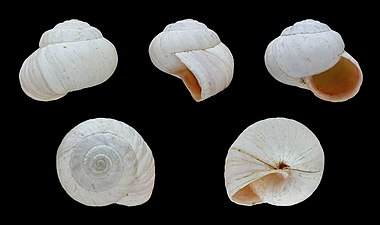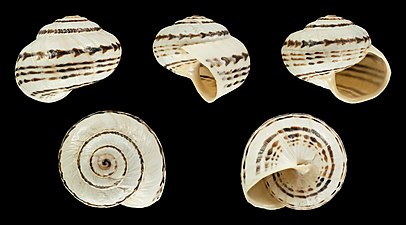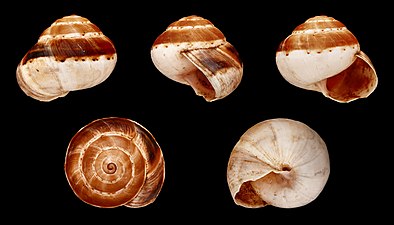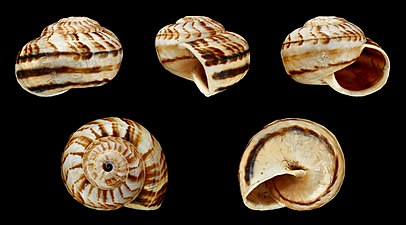Theba pisana

| Theba pisana | |
|---|---|
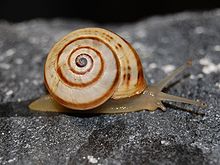 | |
| A live and active individual of Theba pisana | |
| Scientific classification | |
| Domain: | Eukaryota |
| Kingdom: | Animalia |
| Phylum: | Mollusca |
| Class: | Gastropoda |
| Order: | Stylommatophora |
| Family: | Helicidae |
| Genus: | Theba |
| Species: | T. pisana |
| Binomial name | |
| Theba pisana | |
| Synonyms[2] | |
| |
Theba pisana, common names the white garden snail, sand hill snail, white Italian snail, Mediterranean coastal snail, and simply just the Mediterranean snail, is an edible species of medium-sized, air-breathing land snail, a terrestrial pulmonate gastropod mollusk in the family Helicidae, the typical snails.
This species is native to the Mediterranean region, but it has become an invasive species in many other countries. Theba pisana is a well-known agricultural pest in numerous parts of the world.[3] The shell color varies from white to yellow-brown with light brown spiral markings.[3]
Distribution
[edit]The species is native to the Mediterranean region. The type locality is Italy.[1]
The distribution of T. pisana includes the Mediterranean region and adjacent Atlantic coasts from central Morocco to north western Europe:[4]
- Morocco[4]
- Portugal[4]
- In Spain occasionally also in the interior.[4] It is introduced to Menorca.[4] - A subspecies, T. pisana arietina, from coastal habitats in Spain and Portugal, is on the Red List as Endangered.[4]
- Italy
- Malta[5]
- Greece[4]
- Israel[6]
- Egypt[6]
- Belgium[4]
- central Atlantic islands[4]
The species has been introduced to numerous other areas, including:
- southwestern England and south Wales,[4] Great Britain:[7] - introduced since at least the 1700s[4]
- eastern and southern Ireland - introduced since at least the 1700s and it is still spreading along frost-free coastal localities.[4]
- Netherlands - non-indigenous
- the United States in California
- parts of Africa
- Asia
- southeastern Australia, southwestern Australia and Tasmania[8]
- South Africa[3] - It was introduced into South Africa prior to 1881.[3] It has invaded the fynbos biome in South Africa.[3] Given the very high densities that T. pisana can attain at some sites, plus their apparently not particular feeding habits, their potential impact on the vegetation is cause for concern and should be further investigated.[3]
In many of these places T. pisana has become a problematic invasive species and a serious agricultural pest.
This species is already established in the US, and is considered to represent a potentially serious threat as a pest, an invasive species which could negatively affect agriculture, natural ecosystems, human health or commerce. Therefore, it has been suggested that this species be given top national quarantine significance in the USA.[9]
- Theba pisana pisana
- Theba pisana pisana
- Theba pisana ampullacea
- Theba pisana ampullacea
- Theba pisana carpiensis
- Theba pisana concolor
- Theba pisana dermoi
- Theba pisana fauxrosea
- Theba pisana ferruginea
- Theba pisana lineolata
- Theba pisana major
- Theba pisana minor
- Theba pisana musica
- Theba pisana semifulva
- Theba pisana sertum
Description
[edit]

The shell background color is a creamy white. Different individuals may have shells with varying degrees of pale to dark brown markings. The markings, when present, may be in the form of uninterrupted spiral bands, spiral dotted lines, or small radial smudges.
The shell can be found in various colour variants, but is basically yellow or white with dark color bands or spots and often a dark bluish grey apex.[4] The shells of juveniles are sharply keeled, however the keel is not present on the final adult whorl.[4] The aperture often has a lip that is light reddish on the inside, and the lip margin is only reflected at columellar side.[4] The umbilicus is narrow and half covered by the reflected columellar margin.[4] The apex has a characteristic size in the eastern Mediterranean when compared with other species, where there are no other Theba species.[4] The umbilicus is also rarely seen in other species.[4] Juveniles of Eobania vermiculata have a considerably larger apex.[4]
The width of the shell is 12–25 mm,[4] but in Greece the adult shells are usually below 15 mm in width.[4] The height of the shell is 9–20 mm.[4] The visible soft parts are very light yellowish with dark colour bands running from the sides to the upper tentacles; the tentacles are very long.[4]
This snail is sometimes confused with Cernuella virgata, a species with a much smaller and less inflated shell.
Ecology
[edit]

Theba pisana usually lives in coastlands, in or near sandy habitats. In hot climates it aestivates often directly exposed to the sun, attached to grasses, shrubs or succulent plants, fence posts, tall weeds, and so on. It is common near beaches. In dunes it can live on nearly bare sand that is poorly fixed in place by grasses. In colder regions the snails do not aestivate, but they do climb on plants in dry weather. This snail does not survive serious winter frosts.[4]
Theba pisana is often associated with two other land snail species Cochlicella acuta and Cernuella virgata, but it can live slightly deeper inside pure sandy habitats, and is usually more common than Cochlicella acuta.[4] It is one of the most common snails in coastal regions from south Portugal to Greece.[4]
In South Africa, a study showed that these snails were most abundant along roadsides; densities decreased dramatically with distance from roads.[3] The snails were observed to be living on a variety of endemic and introduced plant species; these snails appear to be able to eat an unusually wide range of different food sources.[3] Theba pisana is also a significant pest of citrus, vines, legume crops and cereals in South Africa.[3] In Australia, it feeds on a range of agricultural plants.[3]
Most T. pisana snails have an annual life cycle, breeding in summer and autumn, but a few also take 2 years to mature.[10] In aestivating T. pisana populations in Israel some individuals retain an immature size and shape and a rudimentary status of the genital system, defined as 'infantiles'; the populations of T. pisana may be self-regulated by the mechanism of infantilism or controlled by humidity or, perhaps, by both.[11] In South Africa, T. pisana appear to have an annual lifecycle, breeding in autumn to winter and growing to adult size of about 14 mm diameter by the end of the following summer.[3] Maturity is reached at half maximum shell size after 1 year.[4] Maximum shell size is attained after 2 years.[4] This species of snail makes and uses love darts. The size of the egg is 2.2 mm.[12] In South Africa, the population density can reach up to 300-700 snails m2.[3]
In South Africa, these snails are active mostly at night and especially during periods of high humidity, irrespective of temperature.[3]
Parasites
[edit]Theba pisana is an intermediate host for the terrestrial trematode parasite Brachylaima cribbi.[13]
Impact of invasions
[edit]In addition to the direct negative effect of T. pisana feeding on agricultural crops, it also has several other additional effects. It uses the stalks of cereals as aestivating sites, which in turn clogs machinery and fouls produce during mechanical harvesting.[3]
According to Quick (1952)[14]Theba pisana has been responsible for the extermination of native snail species as a result of competition for available food.[3]
In their report on the status and potential impacts of alien invasive organisms in the fynbos biome, MacDonald & Jarman (1984)[15] predicted that T. pisana would have very little impact on ecosystem processes, such as nutrient cycling, energy flow and sediment dynamics or on the germination and succession processes of the plant community itself.[3] However, the snail could seriously impact directly on fynbos plants, by feeding on them, and also displace native herbivores by competing with them for resources, and these effects have not been studied.[3]
References
[edit]This article incorporates public domain text from the reference[4] and CC-BY-3.0 text from the reference[3]
- ^ a b Müller O. F. (1774). Vermivm terrestrium et fluviatilium, seu animalium infusoriorum, helminthicorum, et testaceorum, non marinorum, succincta historia. Volumen alterum. pp. I-XXXVI, 1-214. Havniae & Lipsiae. (Heineck & Faber). page 60-61.
- ^ "Synonyms of Helix pisana". AnimalBase, accessed 11 May 2011.
- ^ a b c d e f g h i j k l m n o p q r Odendaal L. J., Haupt T. M. & Griffiths C. L. (2008). "The alien invasive land snail Theba pisana in the West Coast National Park: Is there cause for concern?". Koedoe - African Protected Area Conservation and Science 50(1): 93-98. abstract, doi:10.4102/koedoe.v50i1.153.
- ^ a b c d e f g h i j k l m n o p q r s t u v w x y z aa ab ac "Species summary for Theba pisana". AnimalBase, last modified 2 February 2011, accessed 11 May 2011.
- ^ Kolouch, Luboš R. (2003-07-10). "Suchozemští, sladkovodní a brakičtí měkkýši ostrovů Malty [Terrestrial, freshwater and brackish mollusca of Malta islands]". Malacologica Bohemoslovaca (in Czech). 2: 43–50. doi:10.5817/MaB2003-2-43. ISSN 1336-6939.
- ^ a b Commonwealth of Australia. (April 2002). "Citrus Imports from the Arab Republic of Egypt. A Review Under Existing Import Conditions for Citrus from Israel" Archived 2009-01-09 at the Wayback Machine. Agriculture, Fisheries and Forestry, Australia. Caption: Gastropods, page 12 and Appendix 2.
- ^ Kerney M. P. & Cameron R. A. D. (1979). A field guide to the land snails of Britain and northwestern Europe. - Collins, London.
- ^ Clarke, G. M., Gross, S., Matthews, M., Catling, P. C., Baker, B., Hewitt, C. L., Crowther, D., & Saddler, S. R. 2000, Environmental Pest Species in Australia, Australia: State of the Environment, Second Technical Paper Series (Biodiversity), Department of the Environment and Heritage, Canberra.
- ^ Cowie R. H., Dillon R. T., Robinson D. G. & Smith J. W. (2009). "Alien non-marine snails and slugs of priority quarantine importance in the United States: A preliminary risk assessment". American Malacological Bulletin 27: 113-132. PDF Archived 2016-06-16 at the Wayback Machine.
- ^ Cowie, Robert H. (1984). "The Life-Cycle and Productivity of the Land Snail Theba pisana (Mollusca: Helicidae)". Journal of Animal Ecology. 53 (1): 311–325. doi:10.2307/4359. ISSN 0021-8790. JSTOR 4359.
- ^ Moran, Shmuel (1989-06-01). "Weather- and population density-induced infantilism in the landsnailTheba pisana in a semi-arid climate". International Journal of Biometeorology. 33 (2): 101–108. doi:10.1007/BF01686286. ISSN 1432-1254.
- ^ Heller J.: Life History Strategies. in Barker G. M. (ed.): The biology of terrestrial molluscs. CABI Publishing, Oxon, UK, 2001, ISBN 0-85199-318-4. 1-146, cited page: 428.
- ^ Butcher A. R. & Grove D. I. (2006). "Seasonal variation in rates of sporocyst and metacercarial infection by Brachylaima cribbi in helicid and hygromiid land snails on the Yorke Peninsula, South Australia". Australian Journal of Zoology 53(6): 375-382. abstract.
- ^ Quick H. E. (1952). "Emigrant British snails". Proceedings of the Malacological Society of London 29(5): 181-189.
- ^ MacDonald I. A. W. & Jarman M. L. (1984). "Invasive alien organisms in the terrestrial ecosystems of the fynbos biome, South Africa". South African National Scientific Programmes Report No. 85.
Further reading
[edit]- Baker G. H. & Hawke B. G. (1990). "Life History and Population Dynamics of Theba pisana (Mollusca: Helicidae) in a Cereal-Pasture Rotation". Journal of Applied Ecology 27(1): 16–29. JSTOR.
- Baker G. H. & Vogelzang B. K. (1988). "Life-history, population dynamics and polymorphism of Theba pisana (Mollusca: Helicidae) in Australia". Journal of Applied Ecology 25(3): 867–887. JSTOR.
- Cowie R. H. (1985). "Microhabitat choice and high temperature tolerance in the land snail Theba pisana (Mollusca: Gastropoda)". Journal of Zoology 207(2): 201–211. doi:10.1111/j.1469-7998.1985.tb04924.x.
- Durr H. J. R. (1946). "A contribution to the morphology and bionomics of Theba pisana (Muller) (Gastropoda: Helicidae)". South African Department of Agriculture. Stellenbosch-Elsenburg Science Series 47: 1-34.
- Gess S. & Gess F. (2007). "Snail Invasion: The potential impact of the invasive Mediterranean snail, Theba pisana on our coastal dune vegetation". Veld and Flora 93: 216–218.
- Hazel W. N. & Johnson M. S. (1990). "Microhabitat choice and polymorphism in the land snail Theba pisana (Müller)". Heredity 65: 449–454. doi:10.1038/hdy.1990.116.
- McQuaid C. D., Branch G. M. & Frost P. G. (1979). "Aestivation behaviour and thermal relations of the pulmonate Theba pisana in a semi-arid environment". Journal of Thermal Biology 4(1): 47–56. doi:10.1016/0306-4565(79)90045-7.
External links
[edit]- Animalbase.uni-goettingen.de: Theba pisana — at Animalbase: taxonomy, short description, distribution, biology, status (threats), images.
- Encyclopedia of Life—EOL.org Theba pisana images
- Pestalert.org: Theba pisana (white garden snail)
- Ifas.ufl.edu: White garden snail — University of Florida Institute of Food and Agricultural Sciences "Featured Creatures website."
- Snailcream.in.th: White garden snail - Images of shell variations in C. hortensis (Thai language translate).

